Understanding Urban Growth and Shrinkage: A Study of the Modern Manufacturing City of Dongguan, China
Abstract
1. Introduction
2. Literature Review
2.1. Urban Shrinkage
2.2. Factors of Urban Growth and Shrinkage
2.3. Study Hypothesis
3. Materials and Methods
3.1. Study Area
3.1.1. 2008–2014: Post-Financial Crisis Recovery
3.1.2. 2015–2019: Machinery Replaces Human Workers
3.1.3. 2020–2023: COVID-19 Pandemic and Recovery
3.2. Data Source
3.3. Analysis of the Spatial and Temporal Patterns of Growth and Shrinkage in Dongguan City
3.4. Analysis of Factors Affecting Urban Economic Growth and Shrinkage in Dongguan City
3.5. Field Research and Qualitative Analysis
3.6. Research Methods
- Y: the level of urban economic development, represented by GDP;
- Xi: independent variables, representing the specific indicators selected from each dimension;
- β0: the intercept term, indicating the theoretical value of the dependent variable when all independent variables are zero;
- βi: the regression coefficients to be estimated, representing the extent of the impact of a one-unit increase in the independent variable Xi on the dependent variable Y;
- ε: the random error term, assumed to follow a normal distribution with a mean of 0, constant variance, and independence.
- 1.
- Data standardization:
- 2.
- Model Fitting and Evaluation:
- 3.
- Multicollinearity Test:
- 4.
- Residual Analysis and Model Validity Testing.
4. Results
4.1. Spatial Patterns of Urban Growth and Shrinkage in Dongguan Across Different Periods
4.1.1. 2008–2014: Post-Financial Crisis Recovery
4.1.2. 2015–2019: Machines Replace Humans
4.1.3. 2020–2023: COVID-19 Pandemic and Recovery
4.2. Factors Influencing Growth and Shrinkage in Dongguan
4.2.1. 2008–2014: Post-Financial-Crisis Recovery
4.2.2. 2015–2019: Machines Replace Humans
4.2.3. 2020–2023: COVID-19 Pandemic and Recovery
4.2.4. Horizontal Comparison of Factors Across Three Phases
4.3. Dynamic Coupling Mechanisms of Urban Growth and Shrinkage in Houjie Town
4.3.1. Policy Support: From Fiscal Relief to Innovation Incentives and Order-Driven Strategies
4.3.2. Spatial Adaptation: From Extensive Expansion to Intensive Renewal and Job–Housing Balance
4.3.3. Enterprise Transformation: From Emergency Response to Smart Upgrading and Flexible Adaptation
5. Discussion
5.1. Realistic Reasons for Phased Differences in Urban Growth and Shrinkage in Dongguan City
5.2. Shortcomings in Houjie Town’s Response Mechanisms
5.3. Recommendations for Optimizing Response Mechanisms for Urban Growth and Shrinkage
5.3.1. Optimize Labor Structure and Strengthen Worker Support
5.3.2. Increase R&D Investment and Create New Incentive Mechanisms
5.3.3. Accelerate Construction of Public Services and Enhance Comprehensive Service Capacity
6. Conclusions
Author Contributions
Funding
Data Availability Statement
Acknowledgments
Conflicts of Interest
Abbreviations
| MLR | Multiple linear regression model |
| OLS | Ordinary least squares |
| VIF | Variance inflation factor |
| PCA | Principal component analysis |
References
- Kärrholm, M.; Nylund, K.; de la Fuente, P.P. Spatial resilience and urban planning: Addressing the interdependence of urban retail areas. Cities 2014, 36, 121–130. [Google Scholar] [CrossRef]
- Du, Z.; Zhang, H.; Huang, G.; Jin, L. Local state responses to crisis-induced shrinkage in the world’s factory Dongguan, China: Regional resilience perspective. J. Urban Plan. Dev. 2021, 147, 5021021. [Google Scholar] [CrossRef]
- Martinez-Fernandez, C.; Weyman, T.; Fol, S.; Audirac, I.; Cunningham-Sabot, E.; Wiechmann, T.; Yahagi, H. Shrinking cities in Australia, Japan, Europe and the USA: From a global process to local policy responses. Prog. Plan. 2016, 105, 1–48. [Google Scholar] [CrossRef]
- Xu, Z.; Chang, J.; Wang, Z.; Li, Z.; Liu, X.; Chen, Y.; Wei, Z.; Sun, J. Regional Urban Shrinkage Can Enhance Ecosystem Services—Evidence from China’s Rust Belt. Remote Sens. 2024, 16, 3040. [Google Scholar] [CrossRef]
- Chen, T.; Hui, E.C.M.; Tu, Y.; Lang, W. Growth or Shrinkage: Discovering Development Patterns and Planning Strategies for Cross-Border Areas in China. J. Urban Plan. Dev. 2021, 147, 05021046. [Google Scholar] [CrossRef]
- Long, Y.; Wu, K. Shrinking cities in a rapidly urbanizing China. Environ. Plan. A Econ. Space 2016, 48, 220–222. [Google Scholar] [CrossRef]
- He, S.Y.; Lee, J.; Zhou, T.; Wu, D. Shrinking cities and resource-based economy: The economic restructuring in China’s mining cities. Cities 2017, 60, 75–83. [Google Scholar] [CrossRef]
- Li, H.; Mykhnenko, V. Urban shrinkage with Chinese characteristics. Geogr. J. 2018, 184, 398–412. [Google Scholar] [CrossRef]
- Batunova, E.; Perucca, G. Population shrinkage and economic growth in Russian regions 1998–2012. Reg. Sci. Policy Pract. 2020, 12, 595–610. [Google Scholar] [CrossRef]
- Eraydin, A.; Özatağan, G. Pathways to a resilient future: A review of policy agendas and governance practices in shrinking cities. Cities 2021, 115, 103226. [Google Scholar] [CrossRef]
- Jin, Y.; Zhou, G.; Sun, H.; Fu, H.; Wu, H.; Liu, Y. Regrowth or smart decline? A policy response to shrinking cities based on a resilience perspective. Sustain. Cities Soc. 2024, 108, 105431. [Google Scholar] [CrossRef]
- Karp, D.N.; Bagchi-Sen, S.; Rogerson, P. Not all shrinking places are similar: The variegated nature of population decline in the United States. Appl. Geogr. 2022, 138, 102581. [Google Scholar] [CrossRef]
- Derudder, B.; Cao, Z.; Liu, X.; Shen, W.; Dai, L.; Zhang, W.; Caset, F.; Witlox, F.; Taylor, P.J. Changing Connectivities of Chinese Cities in the World City Network, 2010–2016. Chin. Geogr. Sci. 2018, 28, 183–201. [Google Scholar] [CrossRef]
- Raźniak, P.; Dorocki, S.; Winiarczyk-Raźniak, A. Permanence of economic potential of cities based on sector development. Chin. Geogr. Sci. 2017, 27, 123–136. [Google Scholar] [CrossRef]
- Du, Z.; Jin, L.; Ye, Y.; Zhang, H. Characteristics and influences of urban shrinkage in the exo-urbanization area of the Pearl River Delta, China. Cities 2020, 103, 102767. [Google Scholar] [CrossRef]
- Häußermann, H.; Siebel, W. Die schrumpfende Stadt und die Stadtsoziologie. Soziologische Stadtforschung 1988, 29, 78–94. [Google Scholar]
- Hollander, J.B.; Pallagst, K.; Schwarz, T.; Popper, F.J. Planning shrinking cities. Prog. Plan. 2009, 72, 223–232. [Google Scholar]
- Martinez Fernandez, C.; Audirac, I.; Fol, S.; Cunningham Sabot, E. Shrinking cities: Urban challenges of globalization. Int. J. Urban Reg. Res. 2012, 36, 213–225. [Google Scholar] [CrossRef] [PubMed]
- Wiechmann, T.; Bontje, M. Responding to Tough Times: Policy and Planning Strategies in Shrinking Cities; Taylor & Francis: London, UK, 2015; Volume 23, pp. 1–11. [Google Scholar]
- Kim, Y.E.; Lee, J.S.; Kim, S. Proposing the classification matrix for growing and shrinking cities: A case study of 228 districts in South Korea. Habitat. Int. 2022, 127, 102644. [Google Scholar] [CrossRef]
- Chen, X.; Lang, W.; Yuan, Y.; Yan, G.; Hou, X. Conceptualizing the nexus between spatiotemporal shrinkage patterns of natural cities and driving mechanisms: Insights into urban shrinkage in Northeast China. Cities 2024, 152, 105179. [Google Scholar] [CrossRef]
- Wiechmann, T.; Pallagst, K.M. Urban shrinkage in Germany and the USA: A Comparison of Transformation Patterns and Local Strategies. Int. J. Urban Reg. Res. 2012, 36, 261–280. [Google Scholar] [CrossRef] [PubMed]
- Haase, A.; Bernt, M.; Großmann, K.; Mykhnenko, V.; Rink, D. Varieties of shrinkage in European cities. Eur. Urban Reg. Stud. 2016, 23, 86–102. [Google Scholar] [CrossRef]
- Mallach, A.; Haase, A.; Hattori, K. The shrinking city in comparative perspective: Contrasting dynamics and responses to urban shrinkage. Cities 2017, 69, 102–108. [Google Scholar] [CrossRef]
- Newman, G.; Hollander, J.B.; Lee, J.; Gu, D.; Kim, B.; Lee, R.J.; Horney, J.A.; Bearfield, D.; Li, Y. Smarter shrinkage: A neighborhood-scaled rightsizing strategy based on land use dynamics. J. Geovis. Spat. Anal. 2018, 2, 11. [Google Scholar] [CrossRef]
- Wolff, M.; Wiechmann, T. Urban growth and decline: Europe’s shrinking cities in a comparative perspective 1990–2010. Eur. Urban Reg. Stud. 2018, 25, 122–139. [Google Scholar] [CrossRef]
- Hattori, K.; Kaido, K.; Matsuyuki, M. The development of urban shrinkage discourse and policy response in Japan. Cities 2017, 69, 124–132. [Google Scholar] [CrossRef]
- Turok, I.; Mykhnenko, V. Resurgent European cities? Urban Res. Pract. 2008, 1, 54–77. [Google Scholar] [CrossRef]
- Miljanović, D.; Vuksanović-Macura, Z.; Doljak, D. Rethinking the spatial transformation of postsocialist cities: Shrinking, sprawling or densifying. Cities 2023, 140, 104443. [Google Scholar] [CrossRef]
- Chen, T.; Li, X. Cross-Boundary Cooperation and Changes in the Roles of Governments at Different Levels in China: A Case Study of the Guangzhou-Foshan Metropolitan Area. China City Plan. Rev. 2023, 187, 73–83. [Google Scholar] [CrossRef]
- Deng, T.; Wang, D.; Yang, Y.; Yang, H. Shrinking cities in growing China: Did high speed rail further aggravate urban shrinkage? Cities 2019, 86, 210–219. [Google Scholar] [CrossRef]
- Wang, T.; Wu, K.; Yao, C.; Liu, X. Complex Pathways to Population Shrinkage: Case Study of Hegang City, China. Chin. Geogr. Sci. 2022, 32, 418–437. [Google Scholar] [CrossRef]
- Li, X.; Hui, E.C.; Lang, W.; Zheng, S.; Qin, X. Transition from factor-driven to innovation-driven urbanization in China: A study of manufacturing industry automation in Dongguan City. China Econ. Rev. 2020, 59, 101382. [Google Scholar] [CrossRef]
- Salvati, L.; Zambon, I. The (metropolitan) city revisited: Long-term population trends and urbanization patterns in Europe, 1950–2000. Popul. Rev. 2019, 58, 145–171. [Google Scholar] [CrossRef]
- Salvati, L. Exploring long-term urban cycles with multivariate time-series analysis. Environ. Plan. B Urban Anal. City Sci. 2022, 49, 1212–1227. [Google Scholar] [CrossRef]
- Hartt, M. The diversity of North American shrinking cities. Urban Stud. 2018, 55, 2946–2959. [Google Scholar] [CrossRef]
- Hassink, R. Regional resilience: A promising concept to explain differences in regional economic adaptability? Camb. J. Reg. Econ. Soc. 2010, 3, 45–58. [Google Scholar] [CrossRef]
- Simmie, J.; Martin, R. The economic resilience of regions: Towards an evolutionary approach. Camb. J. Reg. Econ. Soc. 2010, 3, 27–43. [Google Scholar] [CrossRef]
- Wang, J.; Yang, Z.; Qian, X. Driving factors of urban shrinkage: Examining the role of local industrial diversity. Cities 2020, 99, 102646. [Google Scholar] [CrossRef]
- Yang, W. Pro-growth urban policy implementation vs urban shrinkage: How do actors shift policy implementation in shrinking cities in China? Cities 2023, 134, 104157. [Google Scholar] [CrossRef]
- Cao, N.; Wen, Y.; Wang, J.; Gao, X.; Sun, P. Identifying shrinking cities from a physical city perspective and influencing factors: A case study of the Chengdu-Chongqing economic circle in China. Appl. Geogr. 2024, 168, 103314. [Google Scholar] [CrossRef]
- Li, W.; Long, Y. Smart technologies for fighting against pandemics: Observations from China during COVID-19. Trans. Urban Data Sci. Technol. 2022, 1, 105–120. [Google Scholar] [CrossRef]
- Hartt, M.; Bagchi-Sen, S.; Hollander, J.B. The post-pandemic future of shrinking cities. Town Plan. Rev. 2021, 92, 403–409. [Google Scholar] [CrossRef]
- Zhang, J.; Yao, M.; Cenci, J. Rethinking Urban Decline in Post-COVID19: Bibliometric Analysis and Countermeasures. Buildings 2023, 13, 2009. [Google Scholar] [CrossRef]
- OECD. A Systemic Resilience Approach to Dealing with COVID-19 and Future Shocks. OECD Policy Responses to Coronavirus (COVID-19); OECD Publishing: Paris, France, 2020. [Google Scholar]
- Hu, X.; Li, L.; Dong, K. What matters for regional economic resilience amid COVID-19? Evidence from cities in Northeast China. Cities 2022, 120, 103440. [Google Scholar] [CrossRef] [PubMed]
- Lin, Q.; Zhao, S.; Gao, D.; Lou, Y.; Yang, S.; Musa, S.S.; Wang, M.H.; Cai, Y.; Wang, W.; Yang, L. A conceptual model for the coronavirus disease 2019 (COVID-19) outbreak in Wuhan, China with individual reaction and governmental action. Int. J. Infect. Dis. 2020, 93, 211–216. [Google Scholar] [CrossRef]
- Wand, Y.; Diabakange Batatana, M.L.; Bikoumou Gambat, M.H. Public perceptions of government policies to COVID-19: A comparative study in six African countries. Heliyon 2024, 10, e24888. [Google Scholar] [CrossRef] [PubMed]
- Wei, Z.; Xie, R.; Tang, Q.; Chan, E.H.W.; Chen, Y.; Xiao, L.; Chen, T. Planning Strategies for Promoting Spatial Accessibility of Healthcare Facilities in Shrinking Cities: A Case Study of Lufeng in China. J. Urban Plan. Dev. 2024, 150, 5024002. [Google Scholar] [CrossRef]
- Wang, H.; Xu, K. How city shrinkage affect public service provision for disadvantaged groups? Evidence from China. World Dev. 2025, 186, 106823. [Google Scholar] [CrossRef]
- Bontje, M. Facing the challenge of shrinking cities in East Germany: The case of Leipzig. GeoJournal 2004, 61, 13–21. [Google Scholar] [CrossRef]
- Großmann, K.; Bontje, M.; Haase, A.; Mykhnenko, V. Shrinking cities: Notes for the further research agenda. Cities 2013, 35, 221–225. [Google Scholar] [CrossRef]
- Sun, J.; Zhou, T. Urban shrinkage and eco-efficiency: The mediating effects of industry, innovation and land-use. Environ. Impact Asses. 2023, 98, 106921. [Google Scholar] [CrossRef]
- Xie, M.; Feng, Z.; Song, Y.; Guan, H.; Wang, S. How Does Urban Shrinkage Affect Land Use Efficiency? A Case Study of Shrinking Cities in Northeast China. Chin. Geogr. Sci. 2024, 34, 34–51. [Google Scholar] [CrossRef]
- Yang, J.; Huang, X. The 30 m Annual Land Cover Datasets and Its Dynamics in China from 1985 to 2023. Zenodo, 2024. Available online: https://zenodo.org/records/12779975 (accessed on 15 March 2025).
- Li, R.; Dong, L.; Zhang, J.; Wang, X.; Wang, W.; Di, Z.; Stanley, H.E. Simple spatial scaling rules behind complex cities. Nat. Commun. 2017, 8, 1841. [Google Scholar] [CrossRef] [PubMed]
- Yeh, C.; Perez, A.; Driscoll, A.; Azzari, G.; Tang, Z.; Lobell, D.; Ermon, S.; Burke, M. Using publicly available satellite imagery and deep learning to understand economic well-being in Africa. Nat. Commun. 2020, 11, 2583. [Google Scholar] [CrossRef] [PubMed]
- Li, X.; Xu, H.; Chen, X.; Li, C. Potential of NPP-VIIRS nighttime light imagery for modeling the regional economy of China. Remote Sens. 2013, 5, 3057–3081. [Google Scholar] [CrossRef]
- Shi, K.; Huang, C.; Yu, B.; Yin, B.; Huang, Y.; Wu, J. Evaluation of NPP-VIIRS night-time light composite data for extracting built-up urban areas. Remote Sens. Lett. 2014, 5, 358–366. [Google Scholar] [CrossRef]
- Ma, T.; Zhou, C.; Pei, T.; Haynie, S.; Fan, J. Responses of Suomi-NPP VIIRS-derived nighttime lights to socioeconomic activity in China’s cities. Remote Sens. Lett. 2014, 5, 165–174. [Google Scholar] [CrossRef]
- Wang, Q.; Xin, Z.; Niu, F. Analysis of the Spatio-Temporal Patterns of Shrinking Cities in China: Evidence from Nighttime Light. Land 2022, 11, 871. [Google Scholar] [CrossRef]
- Wu, Y.; Shi, K.; Chen, Z.; Liu, S.; Chang, Z. An Improved Time-Series DMSP-OLS-like Data (1992–2023) in China by Integrating DMSP-OLS and SNPP-VIIRS; Harvard Dataverse, V5: 2021. Available online: https://dataverse.harvard.edu/dataset.xhtml?persistentId=doi:10.7910/DVN/GIYGJU (accessed on 15 March 2025).
- Chen, L.; Wang, X.; Hao, Y.; Yin, J.; Chen, D. Population agglomeration, borrowed size and urban economic growth in China. Cities 2024, 155, 105491. [Google Scholar] [CrossRef]
- Zhao, X. The influence of knowledge-intensive service industry agglomeration in the Yangtze River Delta urban agglomeration on regional economy. Heliyon 2024, 10, e25095. [Google Scholar] [CrossRef] [PubMed]
- Zheng, Y.; Lin, C.; Yan, J.; Guo, Y. How to enhance the innovation capacity of technology-based enterprises: A fuzzy set qualitative comparative analysis. Int. Rev. Econ. Financ. 2025, 97, 103817. [Google Scholar] [CrossRef]
- Zhao, Y.; Li, J.; Liu, K.; Shang, C. Impact of urban-rural development and its industrial elements on regional economic growth: An analysis based on provincial panel data in China. Heliyon 2024, 10, e36221. [Google Scholar] [CrossRef] [PubMed]
- Guo, K.; Huang, C.; Zhang, Z.; Diaz Paiz, A.Y.; Chen, W. The impact of new energy industry on environmental and economic benefits: Evidence from China. Energy 2024, 304, 132111. [Google Scholar] [CrossRef]
- Chen, Q.; Guan, X.; Huan, T. The spatial agglomeration productivity premium of hotel and catering enterprises. Cities 2021, 112, 103113. [Google Scholar] [CrossRef]
- Wei, W.; Zhang, W.; Wen, J.; Wang, J. TFP growth in Chinese cities: The role of factor-intensity and industrial agglomeration. Econ. Model. 2020, 91, 534–549. [Google Scholar] [CrossRef]
- Huang, D.; Xu, G.; Li, C.; Yang, S. Effects of high-tech industrial agglomeration and innovation on regional economic development in China: Evidence from spatial-temporal analysis and Spatial Durbin Model. Econ. Anal. Policy 2025, 86, 692–712. [Google Scholar] [CrossRef]
- Fisher, B.; Wit, L.A.D.; Ricketts, T.H. Integrating Economics into Research on Natural Capital and Human Health. Rev. Environ. Econ. Policy 2021, 15, 95–114. [Google Scholar] [CrossRef]
- Odhengo, P.; Lutta, A.I.; Osano, P.; Opiyo, R. Urban green spaces in rapidly urbanizing cities: A socio-economic valuation of Nairobi City, Kenya. Cities 2024, 155, 105430. [Google Scholar] [CrossRef]
- Yan, X.; He, S. Healthcare in cumulatively caused migration: Hong Kong residents’ perceived Mainland healthcare quality and migration intentions in the Greater Bay Area, China. Habitat. Int. 2023, 136, 102828. [Google Scholar] [CrossRef]
- Liu, J.; Li, J. Educational equity, inclusive finance, and sustainable economic growth. Financ. Res. Lett. 2025, 77, 106966. [Google Scholar] [CrossRef]
- Wang, M.; Lei, G.; Gao, Y. Study on the change of urban spatial structure in Three Northeast Provinces of China based on the coupling relationship between POI and nighttime light data. Adv. Space Res. 2024, 74, 4543–4560. [Google Scholar] [CrossRef]
- Kong, W.; Shen, W.; Yu, C.; Niu, L.; Zhou, H.; Zhang, Z.; Guo, S. The neglected cost: Ecosystem services loss due to urban expansion in China from a triple-coupling perspective. Environ. Impact Asses. 2025, 112, 107827. [Google Scholar] [CrossRef]
- Estoque, R.C.; Ooba, M.; Togawa, T.; Hijioka, Y.; Murayama, Y. Monitoring global land-use efficiency in the context of the UN 2030 Agenda for Sustainable Development. Habitat. Int. 2021, 115, 102403. [Google Scholar] [CrossRef]
- Kong, W.; Huang, J.; Niu, L.; Chen, S.; Zhou, J.; Zhang, Z.; Guo, S. Innovative framework for identification and spatiotemporal dynamics analysis of industrial land at parcel scale with multidimensional attributes. Cities 2025, 162, 105958. [Google Scholar] [CrossRef]
- Nelle, A.B. Tackling human capital loss in shrinking cities: Urban development and secondary school improvement in Eastern Germany. Eur. Plan. Stud. 2016, 24, 865–883. [Google Scholar] [CrossRef]
- Bartholomae, F.; Woon Nam, C.; Schoenberg, A. Urban shrinkage and resurgence in Germany. Urban Stud. 2017, 54, 2701–2718. [Google Scholar] [CrossRef]
- Kim, S. Design strategies to respond to the challenges of shrinking city. J. Urban Des. 2019, 24, 49–64. [Google Scholar] [CrossRef]
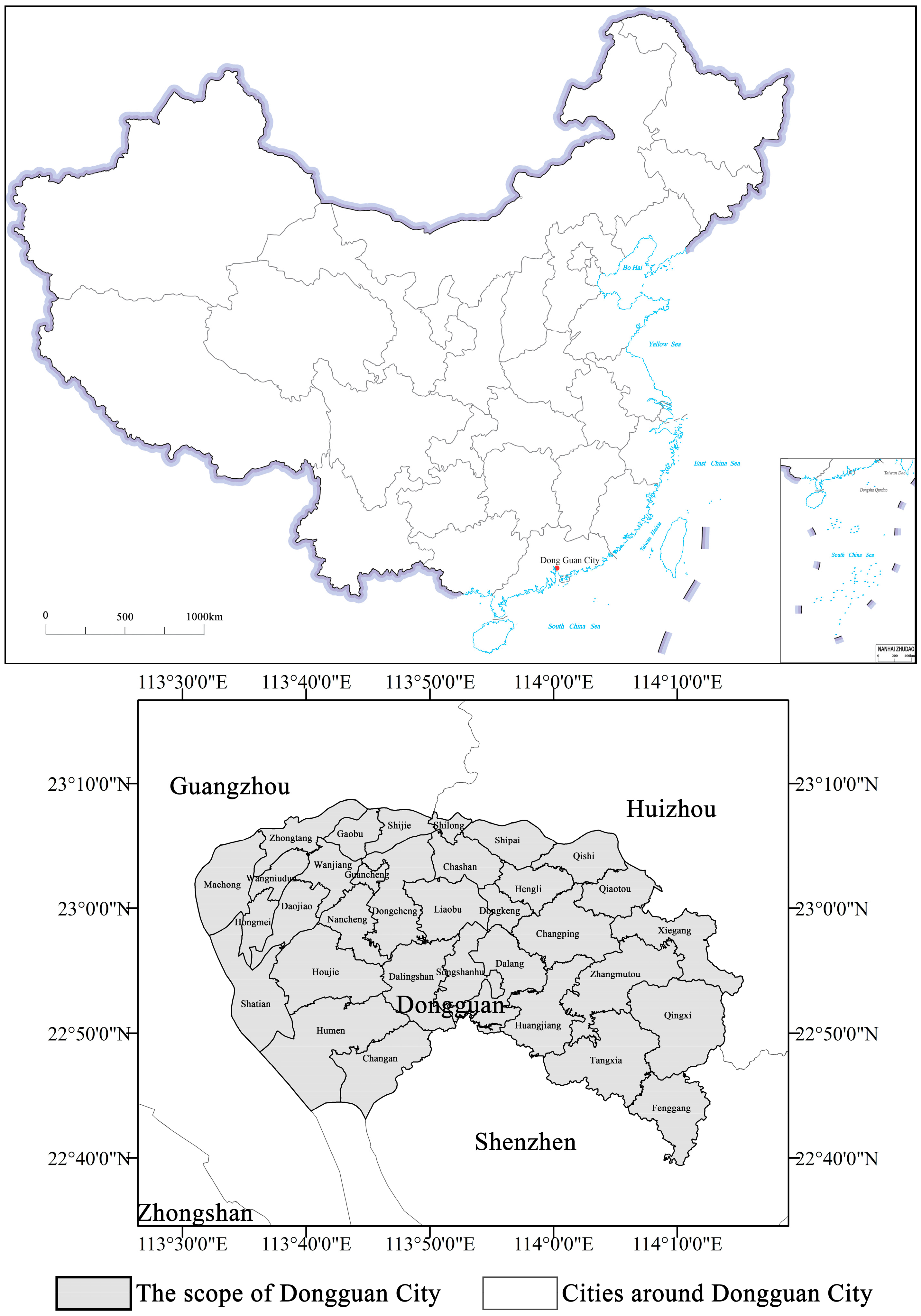
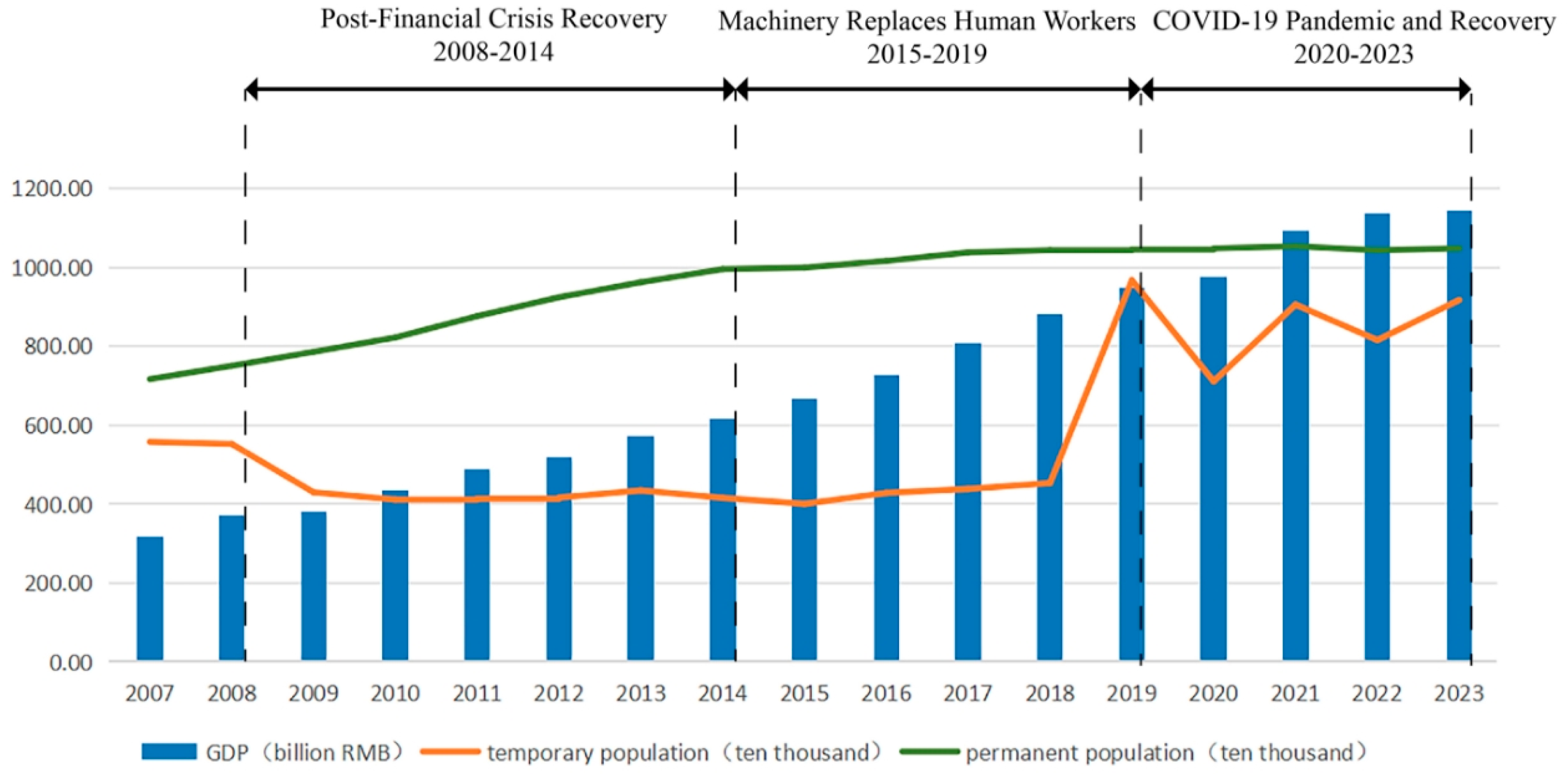
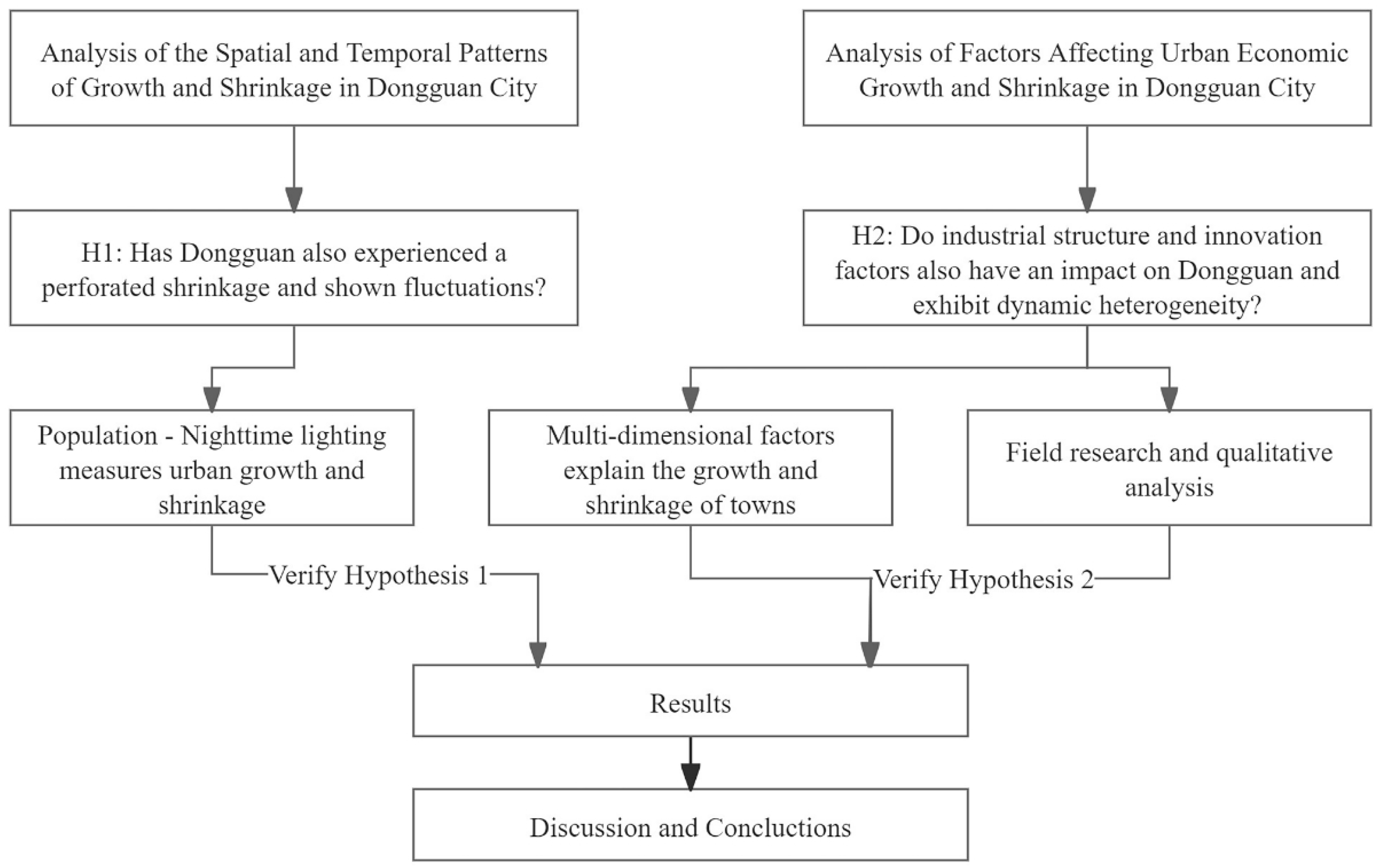
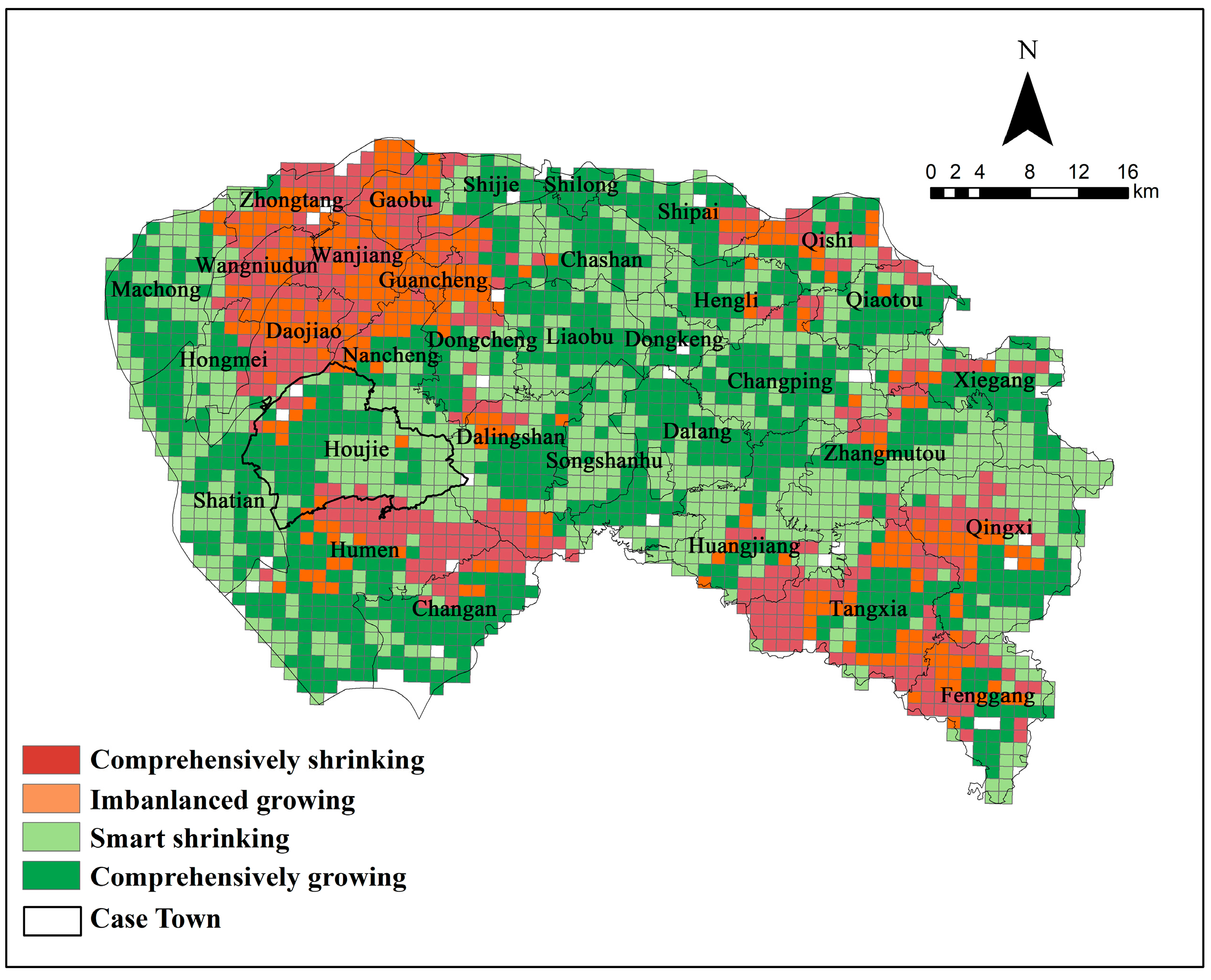
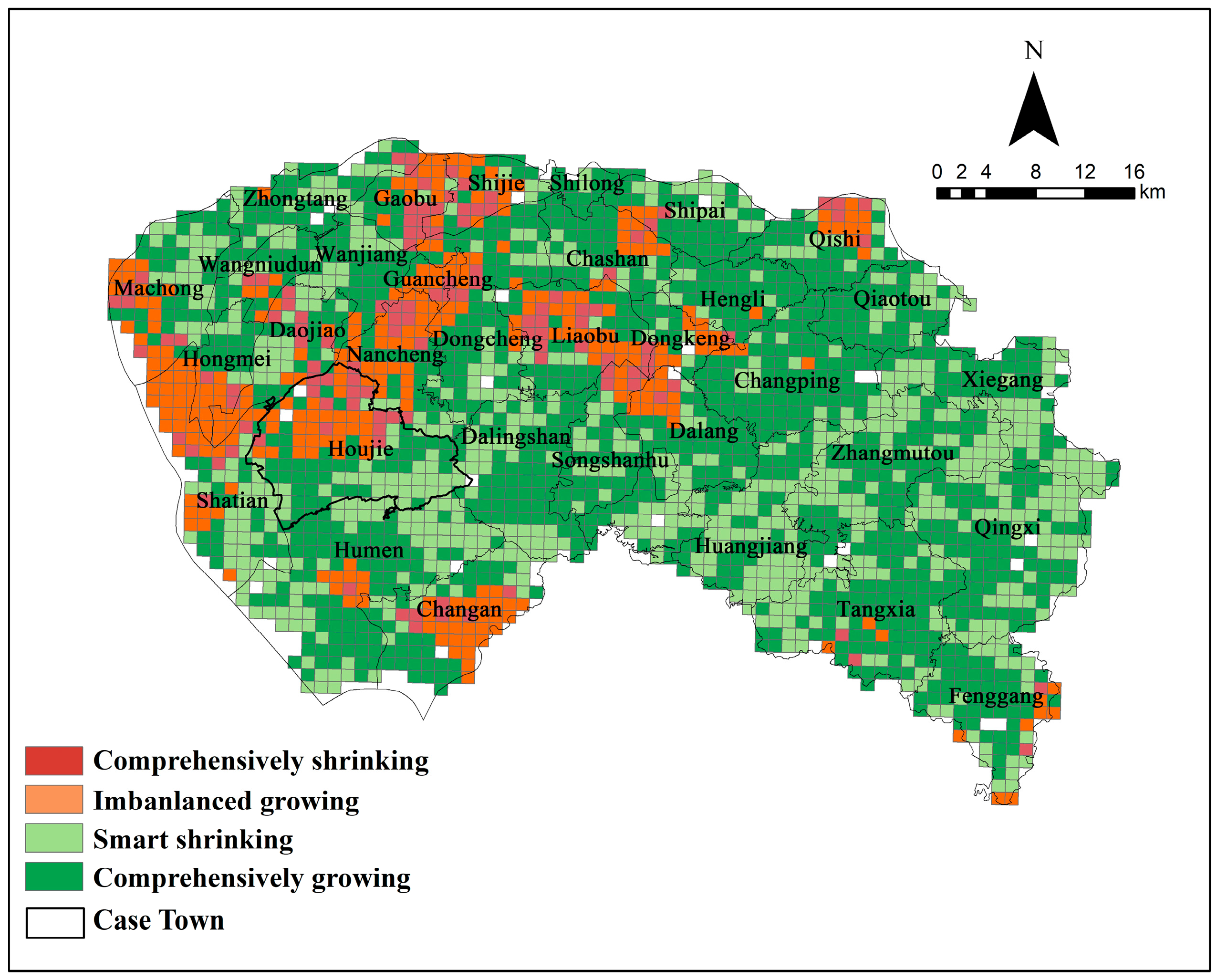

| Dimension | Indicator Name | Indicator Description | References |
|---|---|---|---|
| Population dimension | Permanent resident population | Studies have shown that population agglomeration has a positive impact on economic development. | [63,64] |
| Number of employees in R&D departments | Innovation within enterprises plays an important role in promoting industrial transformation and social development. | [37,41,65] | |
| Industry dimension | Degree of industrial advancement | Among the industrial factors, secondary and tertiary industries are the main driving forces of economic growth, mainly benefiting from the accelerated industrialization process and the rise of the manufacturing industry. | [66,67] |
| Number of industrial enterprises | Agglomeration has important spatial spillover effects on urban economic development, but excessive industrial agglomeration may lead to crowding effects, thereby inhibiting regional economic development. | [68,69] | |
| Kernel density of registered industrial and commercial enterprises | |||
| Number of R&D enterprises | Science- and technology-based enterprises play a core driving role in technological innovation and are the main catalyst for regional technological innovation and economic development. | [65,70] | |
| Public service dimension | Township fiscal expenditure | Studies have shown that government investment in medical and healthcare is an important factor in promoting the high-quality development of the country’s economy. | [64,71] |
| Kernel density of healthcare facility POIs | Urban green spaces bring many benefits to residents, healthcare is a key urban amenity that attracts population migration, and educational equity has a significant driving effect on sustainable regional economic growth. | [72,73,74,75] | |
| Kernel density of science, education, and culture POIs | |||
| Kernel density of sport POIs | |||
| Kernel density of scenic spot POIs | |||
| Land use dimension | Built-up area | In recent years, scholars have focused on the relationship between urban sprawl and socioeconomic development and found that the global land consumption rate is significantly positively correlated with the population growth rate. | [76,77] |
| Industrial land area | Industrial land is an important spatial foundation for economic and social activities, supporting the development of the global manufacturing industry. It is also an important source of carbon emissions and various environmental problems. | [76,78] |
| Unstandardized Coefficients | Standardized Coefficients | t | p | Collinearity Diagnostics | |||
|---|---|---|---|---|---|---|---|
| B | Standard Error | Beta | VIF | Tolerance | |||
| Constant | 8873.585 | 334.386 | - | 26.537 | 0.000 ** | - | - |
| Kernel density of registered industrial and commercial enterprises | 13.369 | 2.276 | 0.106 | 5.873 | 0.000 ** | 1.216 | 0.822 |
| Number of industrial enterprises | −1459.027 | 220.043 | −0.118 | −6.631 | 0.000 ** | 1.167 | 0.857 |
| Industrial structure sophistication | 7716.937 | 417.985 | 0.450 | 18.462 | 0.000 ** | 2.202 | 0.454 |
| Township expenditure | 2.114 | 0.244 | 0.185 | 8.673 | 0.000 ** | 1.698 | 0.589 |
| Kernel density of transportation POIs | 133.905 | 27.693 | 0.131 | 4.835 | 0.000 ** | 2.738 | 0.365 |
| Kernel density of sport POIs | 13.364 | 81.781 | 0.005 | 0.163 | 0.870 | 3.302 | 0.303 |
| Kernel density of healthcare facility POIs | 239.746 | 47.401 | 0.129 | 5.058 | 0.000 ** | 2.412 | 0.415 |
| Kernel density of scenic spot POIs | 340.464 | 340.322 | 0.018 | 1.000 | 0.317 | 1.163 | 0.860 |
| Built-up area | −132.947 | 283.906 | −0.008 | −0.468 | 0.640 | 1.044 | 0.958 |
| Industrial land area | −1068.702 | 157.983 | −0.115 | −6.765 | 0.000 ** | 1.071 | 0.933 |
| R2 | 0.349 | ||||||
| Adjusted R2 | 0.346 | ||||||
| F | F (10,2417) = 129.469, p = 0.000 | ||||||
| D-W statistic | 0.380 | ||||||
| Unstandardized Coefficients | Standardized Coefficients | t | p | Collinearity Diagnostics | |||
|---|---|---|---|---|---|---|---|
| B | Standard Error | Beta | VIF | Tolerance | |||
| Constant | 3173.665 | 383.559 | - | 8.274 | 0.000 ** | - | - |
| Kernel density of registered industrial and commercial enterprises | 4.433 | 0.931 | 0.052 | 4.761 | 0.000 ** | 1.481 | 0.675 |
| Number of industrial enterprises | 2133.855 | 77.347 | 0.324 | 27.588 | 0.000 ** | 1.690 | 0.592 |
| Industrial structure sophistication | 26,643.034 | 535.774 | 0.696 | 49.728 | 0.000 ** | 2.402 | 0.416 |
| Number of R&D enterprises | 1248.486 | 187.197 | 0.106 | 6.669 | 0.000 ** | 3.073 | 0.325 |
| Number of employees in R&D departments | 46.175 | 5.372 | 0.128 | 8.596 | 0.000 ** | 2.729 | 0.366 |
| Township expenditure | 0.735 | 0.097 | 0.114 | 7.594 | 0.000 ** | 2.762 | 0.362 |
| Kernel density of healthcare facility POIs | −13.024 | 22.508 | −0.009 | −0.579 | 0.563 | 2.867 | 0.349 |
| Kernel density of sport POIs | −7.611 | 17.238 | −0.005 | −0.441 | 0.659 | 1.496 | 0.669 |
| Kernel density of transportation POIs | 73.406 | 11.349 | 0.097 | 6.468 | 0.000 ** | 2.767 | 0.361 |
| Kernel density of scenic spot POIs | −104.065 | 80.223 | −0.013 | −1.297 | 0.195 | 1.141 | 0.876 |
| Built-up area | −736.075 | 284.705 | −0.024 | −2.585 | 0.010 ** | 1.017 | 0.984 |
| Industrial land area | −114.359 | 83.668 | −0.016 | −1.367 | 0.172 | 1.651 | 0.606 |
| R2 | 0.804 | ||||||
| Adjusted R2 | 0.803 | ||||||
| F | F (12,2409) = 821.583, p = 0.000 | ||||||
| D-W statistic | 0.413 | ||||||
| Unstandardized Coefficients | Standardized Coefficients | t | p | Collinearity Diagnostics | |||
|---|---|---|---|---|---|---|---|
| B | Standard Error | Beta | VIF | Tolerance | |||
| Constant | 2924.404 | 220.403 | - | 13.268 | 0.000 ** | - | - |
| Kernel density of registered industrial and commercial enterprises | 0.495 | 0.169 | 0.030 | 2.926 | 0.003 ** | 1.351 | 0.740 |
| Number of industrial enterprises | 632.587 | 90.684 | 0.071 | 6.976 | 0.000 ** | 1.337 | 0.748 |
| Number of R&D enterprises | −2485.745 | 163.906 | −0.165 | −15.166 | 0.000 ** | 1.525 | 0.656 |
| Number of employees in R&D departments | 117.556 | 2.204 | 0.563 | 53.326 | 0.000 ** | 1.432 | 0.698 |
| Industrial structure sophistication | −21,573.141 | 289.330 | −0.765 | −74.562 | 0.000 ** | 1.352 | 0.740 |
| Kernel density of sports POIs | 18.668 | 23.020 | 0.009 | 0.811 | 0.417 | 1.622 | 0.617 |
| Kernel density of healthcare facility POIs | 13.845 | 20.364 | 0.007 | 0.680 | 0.497 | 1.532 | 0.653 |
| Kernel density of transportation POIs | 70.755 | 10.812 | 0.066 | 6.544 | 0.000 ** | 1.312 | 0.762 |
| Kernel density of scenic spots POIs | −38.953 | 34.683 | −0.010 | −1.123 | 0.262 | 1.033 | 0.969 |
| Built-up area | −439.375 | 302.776 | −0.013 | −1.451 | 0.147 | 1.023 | 0.977 |
| Industrial land area | −1468.048 | 203.345 | −0.075 | −7.219 | 0.000 ** | 1.388 | 0.721 |
| R2 | 0.812 | ||||||
| Adjusted R2 | 0.811 | ||||||
| F | F (11,2416) = 948.947, p = 0.000 | ||||||
| D-W statistic | 0.432 | ||||||
| Influencing Factors | 2008–2014 | 2015–2019 | 2020–2023 |
|---|---|---|---|
| Kernel density of registered industrial and commercial enterprises | + | + | + |
| Number of industrial enterprises | - | + | + |
| Industrial structure sophistication | + | + | - |
| Number of employees in R&D departments | / | + | + |
| Number of R&D enterprises | / | + | - |
| Township disposable expenditure | + | + | / |
| Kernel density of scenic spot POIs | / | / | / |
| Kernel density of transportation POIs | + | + | + |
| Kernel density of healthcare facility POIs | + | / | / |
| Kernel density of sport POIs | / | / | / |
| Built-up area | / | - | / |
| Industrial land area | + | / | - |
Disclaimer/Publisher’s Note: The statements, opinions and data contained in all publications are solely those of the individual author(s) and contributor(s) and not of MDPI and/or the editor(s). MDPI and/or the editor(s) disclaim responsibility for any injury to people or property resulting from any ideas, methods, instructions or products referred to in the content. |
© 2025 by the authors. Licensee MDPI, Basel, Switzerland. This article is an open access article distributed under the terms and conditions of the Creative Commons Attribution (CC BY) license (https://creativecommons.org/licenses/by/4.0/).
Share and Cite
Chen, T.; Wu, Z.; Lang, W. Understanding Urban Growth and Shrinkage: A Study of the Modern Manufacturing City of Dongguan, China. Land 2025, 14, 1507. https://doi.org/10.3390/land14081507
Chen T, Wu Z, Lang W. Understanding Urban Growth and Shrinkage: A Study of the Modern Manufacturing City of Dongguan, China. Land. 2025; 14(8):1507. https://doi.org/10.3390/land14081507
Chicago/Turabian StyleChen, Tingting, Zhoutong Wu, and Wei Lang. 2025. "Understanding Urban Growth and Shrinkage: A Study of the Modern Manufacturing City of Dongguan, China" Land 14, no. 8: 1507. https://doi.org/10.3390/land14081507
APA StyleChen, T., Wu, Z., & Lang, W. (2025). Understanding Urban Growth and Shrinkage: A Study of the Modern Manufacturing City of Dongguan, China. Land, 14(8), 1507. https://doi.org/10.3390/land14081507








